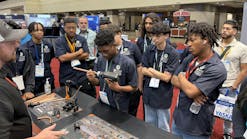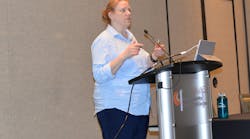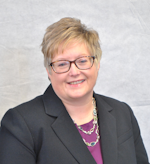Caption: Helen Walter-Terrinoni discusses AHRI’s Safe Refrigerant Transition Task Force with 2020 AHR Expo attendees in Orlando, Fla.
As HFC refrigerants continue to be phased out around the globe, many in the air-conditioning and refrigeration industry look to low global-warming potential refrigerants to take their place. But some of these refrigerants may be more flammable or toxic than HFCs, so education and training is needed, said Helen Walter-Terrinoni, vice president of regulatory affairs at the Air-Conditioning, Heating, and Refrigeration Institute.
Speaking Feb. 4 to HVACR professionals attending the 2020 AHR Show in Orlando, Fla., she discussed AHRI’s Safe Refrigerant Transition Task Force and what it is doing to address each step in the supply chain to ensure the safety of HVACR professionals and the public when using low GWP refrigerants. The American Society of Heating, Refrigerating and Air-Conditioning Engineers classifies refrigerants on the basis of flammability and toxicity.
A2L refrigerants, which are used around the world, are touted as difficult to ignite and less likely to sustain a flame, making them desirable to the HVACR community.
“In the United States, 80 percent of all cars sold contain A2L refrigerants,” Walter-Terrinoni said. “Nearly all new European cars use low GWP refrigerants. Air-conditioning and refrigeration equipment in the European Union, Australia, Japan and Thailand use low GWP refrigerants.”
She added that “flammability risks from A2L refrigerants will be mitigated by a variety of equipment design changes, applicable codes and standards, and training of installers and service technicians.”
ASHRAE, North American Technician Excellence and others are developing new training and testing programs for contractors and technicians installing and maintaining equipment containing A2L refrigerants. ASHRAE is also developing a separate safety standard for residential applications that is focused on clearly communicating safety requirements to contractors and technicians. And the AHRI Safe Refrigerant Transition Task Force is developing training resources for organizations that would like to use it, Walter-Terrinoni explained.
“Significant research is available through third parties and countries such as Japan and Europe,” she said. “This research informed conservative modifications to safety standards.” Nearly $7 million has been invested in the United States to understand low-GWP refrigerants.










